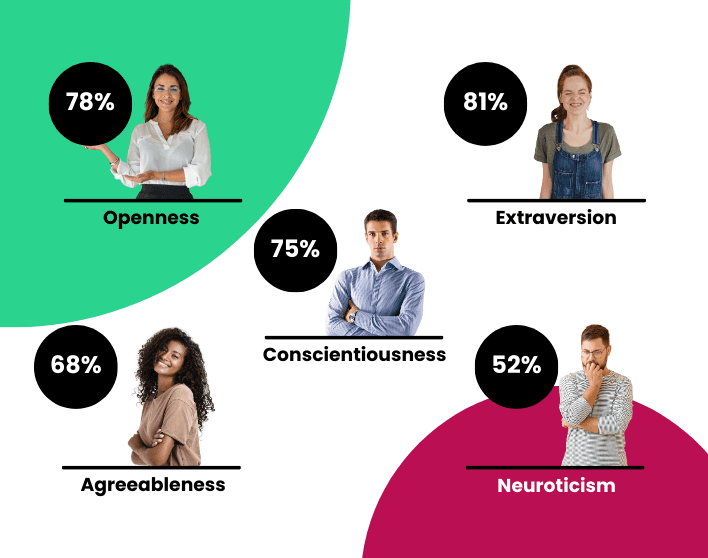The Bryq Team
HR Experts
Diversity in the workplace is a growing trend and there are many reasons why. However, as prevalent as diversity has become in business jargon, it’s not always as easy to shift to diverse hiring practices as we hope it can be.
In fact, one study conducted by SHRM revealed that 41 percent of Fortune 1000 company managers said they are “too busy” to implement a diversity and inclusion program in their organization.
But having a diverse workplace has become a critical component of increasing productivity, innovation, and success. Here is what you need to know about workplace diversity and how you can begin to build your diverse A-Teams and improve your bottom line.
What Is Workforce Diversity?
When we think of diversity, we may first think of race and gender. But a diverse workforce is actually more complex than this. Diversity includes characteristics such as:
Sexual orientation
Religion
Ethnicity
Ability
Socioeconomic status
Age
Experiences
Combining a variety of different levels of these elements can dramatically improve the productivity, cohesion, and innovation of your organization.
Why Is Diversity Important?
Boston Consulting Group did a study that found companies with above-average diversity had 19 percent higher revenue due to innovation than those with below-average diversity.In addition, statistics provided by Catalyst indicated that:
A workforce that represents the diversity of a company’s customer base increases employee productivity.
The majority of American adult consumers consider gender diversity in the workplace important.
“Organizations in the top 25 percent of ethnic/cultural diversity were more likely to achieve above-average profitability—33% for diverse executive teams and 43% for diverse boards.”
According to Glassdoor, “inclusive decision-making leads to better business decisions 87% of the time, reaching those decisions twice as fast in half the meeting times.”
Clearly, the importance of workplace diversity can’t be overstated.
How Can Organizations Improve Diversity?
Before undertaking the task of building a diverse workforce, it helps to identify exactly how diverse your teams already are. Quotas and equality are not the only reasons that today’s millennial employees feel companies should focus on diversity.Aside from doing an internal analysis of those working within your company, getting input from existing employees (consider conducting a Diversity and Inclusion survey) can help you discover strengths and weaknesses when it comes to organizational diversity.
Think about different departments, branches, and locales and do an in-depth analysis of not only age, race, and gender among employees. Consider things like:
Family status
Personality type
Experience
Learning styles
Languages
Disabilities
Once you evaluate these things, take a closer look at departments, positions, or areas that seem to be underrepresented. If the majority of your top leaders are white males, for example, or if your receptionists are all female.
Once you have an idea of where your company stands in diversity, there are steps you can take to improve it.
Begin A Diversity & Inclusion Initiative
1. Get A Buy-In
Change in an organization’s diversity comes from the top down. Before embarking on an effort to improve diversity, be sure your C-suite executives are onboard.
Arrange a meeting and show them the benefits of diversity while also getting their feedback. This helps you to gauge where they stand as well as garner new ideas.
Without a buy-in from your leaders, D&I initiatives can dwindle and die a slow death. Once your leaders know the business advantages of having a diverse team, they will be more inclined to support those efforts.
Of course, including your leadership in the process will help you to further identify any existing issues. Working together, evaluate where your diversity is and determine where you would like to see it grow. This will help in developing a strategy that includes specific goals.
2. Begin Incorporating D&I Activities/Policies/Procedures
Encourage open-door policies for your managers so that employees can feel free to connect and converse. By promoting fairness and equality so that everyone feels their opinions, ideas, and positions are important, your company’s culture will organically begin to shift to one where everyone feels included.
Consider changing the way that meetings are held so that those who are working together to make decisions are able to do so with inclusion and fun. There are creative ways that teams (and companies) can not only foster diversity and inclusion but even allow employees to celebrate and honor it.
Be sure employees are not interrupted when speaking at a meeting.
Ask questions and wait for responses.
Include icebreakers that allow everyone to feel welcomed and appreciated.
Confront bias – and encourage employees to do the same – as soon as it happens.
Fun office games that include everyone can help make work fun and inclusive.
Make sure that all of your existing employees feel they belong and serve a valuable purpose within your organization by having internal employee satisfaction surveys and observing how they interact with one another as well as their managers. This helps to lay the foundation to expand on the diversity of your workplace.
3. Change Recruiting Methodologies
In today’s technological workforce, diversity is much easier to establish than it’s ever been in the past. When it comes to recruiting, there are a few different strategies you can implement to increase the diversity of your team.
We all want to believe we are fair, honest, and just when recruiting but unconscious bias is a real thing that can start with just the name on a resume. Here are some techniques that companies can use to increase the scope of their candidate pools.
Utilize Social Media — Social media allows companies to reach beyond the border and encourages candidates to seek employment from anywhere in the world. SHRM reports that one company effectively using social media for recruiting – ShoreTel, Inc., located in Sunnyvale, CA – actually has only 105 of their 1,000 employees in their physical location. The remainder are spread out largely in other U.S. cities as well as France, India, Singapore, and the UK.
Consider Blind Recruitment — A growing tend for HR is blind recruitment where certain identifying factors are removed such as age, race, gender, names, age, and personal interests. You can utilize the services of a recruiting agency or assign the task of removing identifying information from applicants to a specific person within your organization.
Implement Pre-Employment Assessments — As an extension of blind recruitment, a pre-employment assessment can help cut down on the time and resources spent sifting through candidates’ resumes. Pre-employment assessments measure more than just hard skills; they also identifies personality traits and soft skills that help to narrow down the perfect matches for the position you are looking to fill and since they’re outsourced, there is no chance of unconscious bias.
In Summary
Analyze existing diversity and inclusion.
Talk with organization leaders to inform them of the benefits of diversity and get a buy-in.
Begin incorporating diversity and inclusion activities and practices.
Change recruiting methods to maximize choices from a diverse pool of candidates.
Knowing and implementing these things will ultimately help to make your interviews more meaningful so you can hire the right person for the job.





